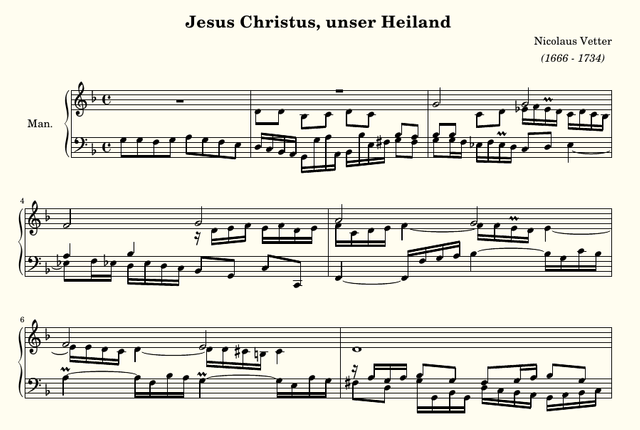Playing with imulse resposes | Nicolaus Vetter, Jesus Christus unser Heiland

The new version of Hauptwerk, the virtual organ software, supports impuls response. That is a technique to add the reverberation of a specific space to sound. Since every organ is unique in sound and disposition and is located in one unique, namely a specific church or concert hall, that opens up enormous possibilities for virtual organs.
The sound reflections of the space the church is located in, defines more than halve of the actual sound of an organ. To emulate that sound at home, sampl sets are created that contain both the sound of the organ recorded nearby and sound of the organ recorded at (for or near) distance. And somtimes recordings are made at more than two locations. So you end up with two or more sets of samples of the complete organ.
That works very good, yet it is also requires a lot of RAM in one's computer, and a powerful enough CPU to process all those samples. With impulse response it is possible to create sample sets that are a bit less power hungry.
The idea is to record the organ close by, so you can hear all the details of the sound each individual pipes makes. That type of recording is called 'Dry' as it contains little or no reflections of the sound caused by the space the organ is located in. Then an impulse response files of the church can be created that contains the information of the sound characteristics of the room or space at a specifiec spot. When you combine the samples, recorded nearby the organ, with the impulse response file, the result is an impression of how the organ sounds at the spot the impulse response file was created.
I write 'impression' because sound is a very complex phenomenon. If you record one organ pipe several times at the same spot in the church, say the spot where the impulse response file was created each recording will be different. With an impulse response file, the result will be exactly the same each time. Even though the result is very convincing, it is and remains a model, an approximation of how the organ would sound in real live.
To experiment a bit with the possibilities of impulse response files I use the the sampleset, made by Sonus Paradisi, of the Hinsz organ in the Reformed church in the Midwolda (http://www.sonusparadisi.cz/en/organs/netherlands/midwolda-surround-sample-set.html). The sample set of that organ was created by using three different recordings: one near the organ ("front"), one a bit more distant ("diffuse"), and one even more distant and with the micrphones heading away from the organ to capture the reflections of the church ("rear").
Normally you would assign the rear samples to a pair of speaker behind you. The front and diffuse samples can be mixed and played through a set of speaker in front of the player. The amount of mixing creates the illusion of different distances from the organ. With 100% front of course giving the impression of being close to the organ, and 100% diffuse giving the impression of being at the spot where the microphones were when recording these samples. Any a=other combination gives the impression of being somewhere between those extremes.
In my setup I use the front samples for my front speakers and the rear samples for the rear speakers. The front samples are really very dry and sound unrealistic because in real life you never hear the organ pipes without hearing the church as well. To these front samples I added an impulse response file. Sadly, not of the real church, as there is not one available as far as I know. Yet that only matters if you know how the organ sounds in the real church. The power of impulse response files is that you can virtually tranfer an organ to any church you'd like to get an impression of how it would sound there.
The proof of the pudding is in the eating, so let's play something by Nicolaus Vetter.
Andreas Nicolaus Vetter (1666-1734) was born in Herschdorf. He studied with Georg Caspar Wecker in Nuremberg and later with Johann Pachelbell in Erfurt. In 1690 he became organist of the Predigerkirche, but he didn’t stay long. In 1691 Vetter went to Rudolstadt to take up a position as castle organist. He was succeeded at the Predigerkirche by Johann Heinrich Buttstett. There are few surviving compositions by Vetter, but what remains show that Vetter was a very able craftsman. He created choral preludes with the style and techniques Pachelbel employed as well. Those techniques were in wide use in that part of Germany in that time. Sometimes it is difficult to descern whether a composition was by Vetter, of Buttstett or Pachelbel or Johann Michael Bach or (fill in one of the many others).
This chorale prelude can be found in manuscript Mus.ms. 22541 III, owned by the Staatsbibliothek zu Berlin. And now the question that was the purpose of this experiment: does the organ sound convincing?

Sonus Paradisi sells IR files and Inspired Acoustics is releasing some soon.
Your post has been supported and upvoted from the Classical Music community (Subscribe at peakd and Steempeak) as it appears to be of interest to our community. We also support jazz and folk music posts!
If you enjoy our support of the #classical-music community, please consider a small upvote to help grow the support account!
You can find details about us below.
The classical music community at #classical-music, Peakd, Steempeak and Discord. Follow our community accounts @classical-music and @classical-radio or follow our curation trail (classical-radio) at SteemAuto!